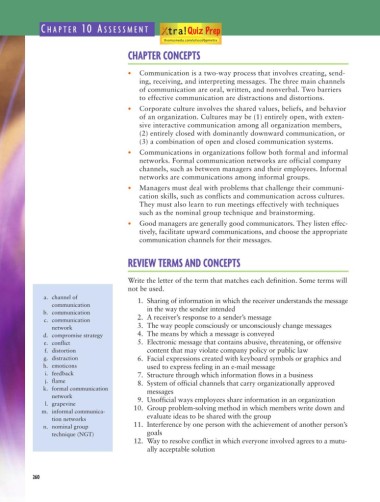Page 273 - Business Principles and Management
P. 273
C HAPTER 10 A SSESSMENT
thomsonedu.com/school/bpmxtra
CHAPTER CONCEPTS
• Communication is a two-way process that involves creating, send-
ing, receiving, and interpreting messages. The three main channels
of communication are oral, written, and nonverbal. Two barriers
to effective communication are distractions and distortions.
• Corporate culture involves the shared values, beliefs, and behavior
of an organization. Cultures may be (1) entirely open, with exten-
sive interactive communication among all organization members,
(2) entirely closed with dominantly downward communication, or
(3) a combination of open and closed communication systems.
• Communications in organizations follow both formal and informal
networks. Formal communication networks are official company
channels, such as between managers and their employees. Informal
networks are communications among informal groups.
• Managers must deal with problems that challenge their communi-
cation skills, such as conflicts and communication across cultures.
They must also learn to run meetings effectively with techniques
such as the nominal group technique and brainstorming.
• Good managers are generally good communicators. They listen effec-
tively, facilitate upward communications, and choose the appropriate
communication channels for their messages.
REVIEW TERMS AND CONCEPTS
Write the letter of the term that matches each definition. Some terms will
not be used.
a. channel of 1. Sharing of information in which the receiver understands the message
communication in the way the sender intended
b. communication 2. A receiver’s response to a sender’s message
c. communication
network 3. The way people consciously or unconsciously change messages
d. compromise strategy 4. The means by which a message is conveyed
e. conflict 5. Electronic message that contains abusive, threatening, or offensive
f. distortion content that may violate company policy or public law
g. distraction 6. Facial expressions created with keyboard symbols or graphics and
h. emoticons used to express feeling in an e-mail message
i. feedback 7. Structure through which information flows in a business
j. flame 8. System of official channels that carry organizationally approved
k. formal communication messages
network 9. Unofficial ways employees share information in an organization
l. grapevine 10. Group problem-solving method in which members write down and
m. informal communica- evaluate ideas to be shared with the group
tion networks
n. nominal group 11. Interference by one person with the achievement of another person’s
technique (NGT) goals
12. Way to resolve conflict in which everyone involved agrees to a mutu-
ally acceptable solution
260

